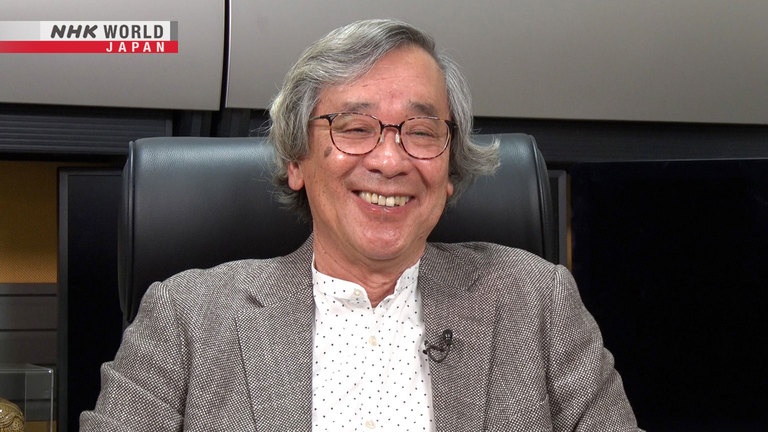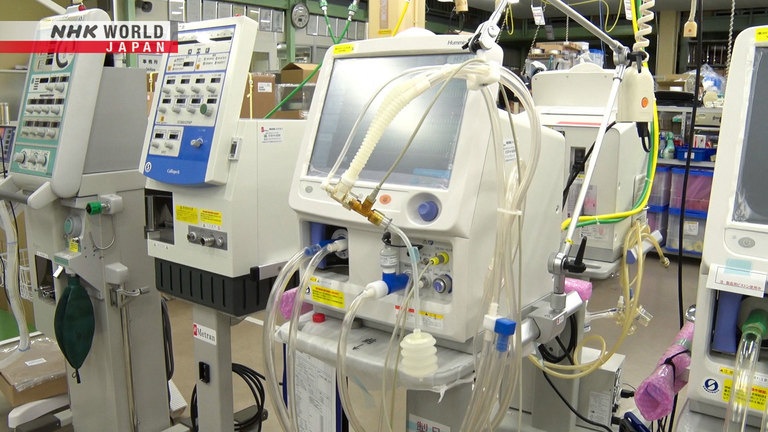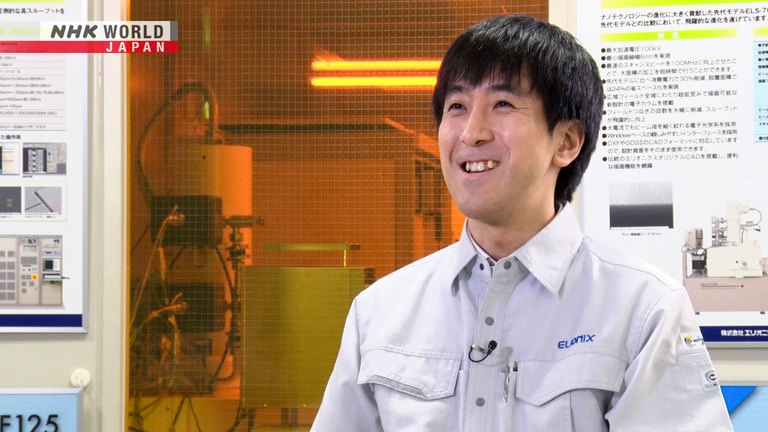Ventilators for Premature Babies / Electron Beam Lithography Systems
The fascinating stories and secrets behind hit Japanese products, plus parts and machines that boast the top share of niche markets. In the first half: the story behind ventilators developed by a Japanese company in 1984 which provide critical care for premature babies. In the second half: electron beam lithography systems, capable of drawing the finest lines in the world. We introduce the Japanese technology that's being used by researchers at universities around the world.



Transcript
"Japan's Top Inventions"
The behind-the-scenes tales of hit productions and creations from Japan.
This is "Japan's Top Inventions."
On today's show... the life of an infant.
We tell the story behind a medical device
that's used to treat premature babies around the world.
Later, these special patterns.
If we zoom in for a closer look...
we can see they're packed with intricate lines.
We dive down into the molecular scale of nanotechnology.
Hello, welcome to "Japan's Top Inventions."
I'm your host, Jason Danielson.
In the first half of our show, we take you "Behind the Creation."
Today's topic is this.
Ventilators for premature babies.
They're capable of delivering small volumes of air,
900 times in a single minute.
These ventilators are an essential tool
in neonatal intensive care units worldwide.
They're frequently used for treating premature babies.
The technology was developed by an immigrant engineer
who decided to stay in Japan after leaving his home country.
This is Metran, a medical device manufacturer in Saitama Prefecture.
It's a small company of around 48 employees,
but the ventilators they make
have been shipped to 30 countries and regions around the world,
including Germany and Canada.
They're an important tool for treating premature babies at the hospital.
Safely stored at the company is this:
Here it is.
One of the company's early models, developed in 1985.
These were first delivered to hospitals in the US.
We made 85 units and sent them to various hospitals in North America
for clinical trials with premature infants.
It's an invaluable piece of our company's history.
Our story begins back in 1968.
The Vietnam War was being widely covered on the news.
Fierce conflict between the North and the South continued to play out.
Far from the war zone, in Tokyo,
one young man followed the news intently.
Tran Ngoc Phuc, the son of a wealthy Vietnamese family.
He had come to Japan for university to study engineering.
He majored in industrial chemistry.
Phuc obtained Japanese citizenship,
and has also taken the Japanese name Nitta Kazufuku.
Here's how he remembers things.
Japan is a highly industrialized nation.
It was way ahead of Vietnam then.
I wanted to study in Japan
and bring that knowledge of production back to my home country.
After graduating,
Phuc was hired as a trainee at a medical device manufacturer.
While Phuc was the odd one out among his Japanese colleagues,
he learned the job just like everyone else.
But then, some startling news reached his ears.
Saigon, the capital of South Vietnam, had fallen.
The communist North took control of the South,
merging the two countries into a single socialist republic.
I thought that this meant
I could never return to my home country of Vietnam.
I'd heard that intellectuals and the wealthy
were being dragged out into the square.
They were being killed for claiming
that the people were getting exploited by the ones in control.
Phuc decided then he would remain in Japan,
and became a permanent employee of the company.
He was given a new task. To develop a new product.
What should be made? Phuc spent many days researching possibilities.
A certain medical device caught his eye. The mechanical ventilator.
At the time, Japanese hospitals were mostly using devices made overseas.
Very few were designed in the country.
Development is a battle of wits.
I thought if I was going to stay in Japan as an immigrant,
if I was considering my future in this country,
it'd be best for me to work on something no one else was doing.
That's why I chose ventilators.
And so, a new project to develop a ventilator began.
Phuc was ready to tackle the challenge head-on.
Phuc's first step was to visit Kyorin University Hospital.
He worked with doctors to learn all about ventilators,
starting from the basics.
There was a ventilator from the US
at the surgical ward of the university hospital.
I committed myself to studying there for half a year.
The commute was three hours one way.
I used the whole 6-hour roundtrip to read research.
Phuc was able to create a ventilator
based off his study of the existing technology.
However, there was an important issue to consider.
The strain that ventilators put on the lungs.
A ventilator sends pressurized volumes of air,
about 15 times a minute.
If the device was used on underdeveloped lungs,
like that of a premature baby, it could cause strain on them.
How could the ventilator be made gentler on the lungs?
Phuc read research from all over the world.
He discovered a certain paper on "high-frequency ventilation."
While ventilators of the time
were sending air about 15 times in a minute,
the paper claimed that a higher frequency of smaller volumes,
around 200 in a minute, was also effective.
Researchers in Sweden had proven in an experiment with a dog
that 200 smaller volumes of air a minute worked.
The dog could live with air being delivered 200 times.
I decided I would also explore this method.
But how could these smaller volumes be achieved?
Phuc turned his attention to this component. The valve.
The valve controlled the flow of the air.
By manipulating how it opened and closed,
he might be able to rapidly deliver the smaller volumes.
Phuc experimented over and over again with prototypes.
Eventually, he was able to come up with an original valve design
that was able to deliver small volumes of air 900 times a minute.
A new kind of ventilator which put less strain on the lungs
had been made.
Following this, Phuc started his own company,
dedicating himself to the development of the ventilator.
He would soon reach out overseas
and take part in a project involving neonatal care.
Phuc was seeking to make the use of his ventilators more common.
In October of 1984, he was presented an opportunity.
The US National Institutes of Health was holding a competition
for the development of ventilators for premature babies.
A certain trend was developing during the 80s in the US.
The number of premature births was rising significantly.
There was a need for new ventilators which could be used safely
on the underdeveloped lungs of a premature baby.
Phuc focused on improving his ventilator
so that it could be used for these infants.
The goal was to offer precise control
over the volume and rate at which air could be delivered,
to make sure it was suitable for any baby.
To get technical,
there are five to six hundred million tiny air sacs in the lungs.
In a premature baby's lungs,
these air sacs are commonly in a collapsed state, like this.
A piston that delivered air by oscillating back and forth
was implemented.
But what could be used to drive and control this movement?
Phuc looked towards this.
A linear motor, similar to those used in high-speed trains.
A conventional motor has to rely on a crank,
but a linear motor could directly and precisely control the piston.
With this, the rate of the air being delivered
could be adjusted for any case.
Phuc asked company after company
whether they could create a small linear motor for him.
But each time, he was turned down.
There were even companies that rejected him
because of his accented Japanese.
But Phuc would not be deterred.
He persevered.
"Please," he said.
"This could save the lives of infants."
Each time I asked,
I was treated like a strange foreigner asking for something ridiculous.
But I kept explaining how it could save the lives of babies.
And finally, I was able to find a company that wanted to help.
That company was probably thinking I was odd,
but somehow I got through to them.
And that was how Phuc implemented the piston and the linear motor.
His ventilator for premature babies was finally finished.
Later, Phuc would present his device at an American hospital in Miami.
Eight other companies were also present,
including major players from the US.
Eight companies had gathered at the Memorial Hospital in Miami.
Forty prominent academics were there to judge which was the best device.
We all had our booths,
and the judges would come around and we would present our devices.
This is a photo from that time of Phuc with his interpreter.
He didn't think a minor company like his
stood much of a chance of winning.
After presenting, Phuc was invited to the home of his interpreter.
Phuc cooked them his specialty. Vietnamese cuisine.
While they were eating...
There was a phone call for the interpreter.
It was someone from the National Institutes of Health.
There were two companies remaining in the finals.
Phuc's device had impressed the judges with its piston and linear motor,
but he thought there was no way he'd win.
At that time, there was a big trade dispute over automobiles
between Japan and the US.
I was personally convinced that the US
would not spend government money on a Japanese ventilator.
Still, Phuc had made it to the finals,
so he wouldn't give up just yet.
He stood by, anxiously awaiting the results.
An hour passed.
The results were in.
They said, "Your device has been chosen."
What a shock that was.
I thought, the US really is a land of opportunity.
The NIH was going to sign a contract and order 85 units.
All the young people at the company worked day and night
until we collapsed from exhaustion.
I collapsed in the end too.
And so, Phuc's ventilator was shipped to hospitals in the United States.
Clinical trials were held,
and the device was proven to be safe for use with premature babies.
And that was how these ventilators for premature babies
came to be used in hospitals around the world.
What do experts have to say about this invention?
We're joined by Miyasaka Katsuyuki,
a doctor that assisted in the development of the ventilator.
Welcome to the show.
Thanks for having me.
As a doctor,
what role did you have in the development of the ventilator?
I taught Mr. Phuc
about the high-frequency oscillation ventilation method
which puts less strain on the lungs.
We normally breathe about ten times in a minute.
Twenty at most.
But this ventilation method goes to 900 times a minute.
It was still at the research stage at the time.
It was the 80s when people first tried to use it on humans.
Mr. Phuc worked out a practical means
to achieve this method of ventilation.
What was groundbreaking about this device?
When you're dealing with premature infants,
you can't be approximate.
You have to be exact.
The really groundbreaking thing was the use of a linear motor.
The way it could drive the piston to push and pull air
is well-suited to how the ventilator works.
With a linear motor, you can control it like a syringe,
injecting and drawing with extreme precision and control.
What impact has this device had on neonatal care?
The lungs of a premature baby are truly delicate.
You have to be very careful when inflating them.
This device was gentler than the ventilators before it.
That was the biggest advantage.
Nowadays, almost 100% of Japanese neonatal intensive care units
use the device.
Japan has one of the lowest infant mortality rates.
Currently, it's at about 1 out of 1,000. It's very low.
I believe this device has made a difference.
Mr. Phuc is still working to improve the technology.
What kind of new developments can we expect?
When I was first introduced to Mr. Phuc,
I had been told there was an extremely motivated engineer
who wanted to make a difference.
He's always thinking about the needs of the patient.
He took an approach that was still at the research stage
and was first in the world to make practical use of it.
Now it's common around the world.
He's is a real pioneer.
His engineers listen to the needs of the doctors,
and develop new medical devices.
I hope he continues to remember what the patients truly require
and create devices that are easy to use.
Thank you for your time. Great talking to you.
Thank you.
"Top Niche Creations."
Our next segment is "Top Niche Creations."
Today, we'll be taking a look at this.
While they take up a lot of space,
these systems are capable of drawing extraordinarily thin lines,
just three nanometers wide!
That's 27 thousand times thinner than a human hair.
How do these machines do it? We went to find out!
This is Elionix, a manufacturer of precision machines in Tokyo.
The company only employs about 100 people
but their machines are used to draw lines in the nanometer scale.
What exactly do they look like?
We got a special demonstration from Kodama Satoshi,
who works in engineering.
First, a round silicon wafer,
a material used for semiconductors is prepared,
about 15 centimeters in diameter.
A very fine pattern will go on here.
The wafer is loaded in.
Next, the desired pattern is entered on the computer.
Click "Start"...
and voila.
This is the result.
If you zoom into the center of one of these patterns
with an electron microscope,
you can see lines which are invisible to the naked eye.
If you zoom in even further...
Here. Lines that are 15 nanometers wide.
15 nanometers is over 5,000 times thinner than a human hair.
How small can you get?
We've been trying to push the limits.
It's an incredibly difficult technical challenge,
but I think it's really rewarding to be going after something like that.
Just how are these lines being drawn? The key component is here.
This cylinder known as the optical column...
A special beam is formed in here
and used to draw the patterns onto the silicon wafer.
Electrons. One of the subatomic particles found in atoms.
A beam of these electrons passes through a series of lenses to focus it.
The focused beam is used to draw the lines of the pattern.
Many different patterns can be entered into the computer
and drawn with the machine.
Electron beam lithography.
Its main use is for electronics like smartphones and PCs,
to make their semiconductor chips.
Extremely fine circuits can be drawn with these machines.
They're contributing to improving the performance
of semiconductor chips.
As the number of circuits increases, so does the processing speed.
The smaller that the elements are, the better.
So we're developing ways to make things even smaller
and pack in more circuits.
The company is dedicated to making finer lines.
This drive has been part of the company since it was founded in 1975.
The engineering group applied electron microscope technology
to develop the electron beam lithography systems.
Their business proved successful
as Japan's semiconductor industry matured.
After that success,
they turned their attention towards the demand in research.
Labs at universities were looking for devices
which could draw thinner lines than ever before
as they researched nanotechnology.
I heard we were occasionally hitting 50 nanometers,
while others were only at the 600 range.
But researchers wanted ten nanometers to do new research.
Our company was an expert in the field,
so it was worthwhile to pursue a goal no one else could reach.
In 1996, after much effort into developing electron guns and lenses,
the company succeeded in drawing lines that were ten nanometers wide,
one-fifth of their earlier model.
But they didn't stop there. Five nanometers, and then four.
In 2018, they reached three nanometers, the thinnest in the world.
Their technical accomplishments
have garnered attention around the world,
and their devices are being used at famous universities like Harvard.
Lately, their work is being used in the research
and development of quantum computers,
capable of solving complex problems
much faster than conventional computers.
When you're at the forefront of nano-scale technology,
even something like making a tiny dot is going to be a necessary process
when creating components for quantum computers.
I'm working with the thought that we're helping to push the field
of nanotechnology forwards.
Electron beam lithography systems.
In addition to reducing the thickness of the lines,
the company is now focusing on reducing the drawing time.
This is a pattern that's been drawn on a silicon wafer.
Normally, this would take about three hours.
But with the latest model, the pattern can be done in half the time.
It's not just about precision, but speed too.
That's all for this episode of "Japan's Top Inventions."
We'll leave you with what came next
for the engineer of the ventilators from the first half of the show.
See you next time! And stay inventive.
(Phuc developed the ventilator for premature babies.)
(Due to COVID-19, new adult-use ventilators were made in 2020.)
(2,000 units were sent to Phuc's home country of Vietnam.)
(Sometimes, he gets letters from children who were saved by his ventilators.)
(They remind him of the importance of his work.)
I never would have imagined that I'd come to Japan
and end up doing this amazing, rewarding work.
It's been like an opportunity from god.
I'm truly thankful.